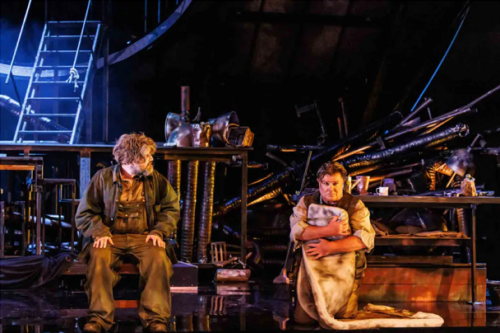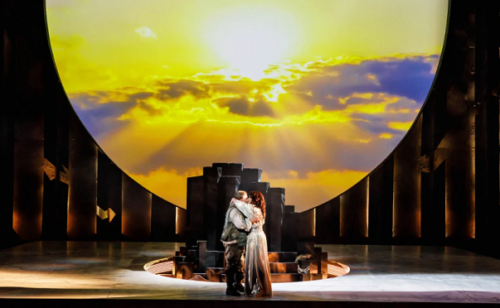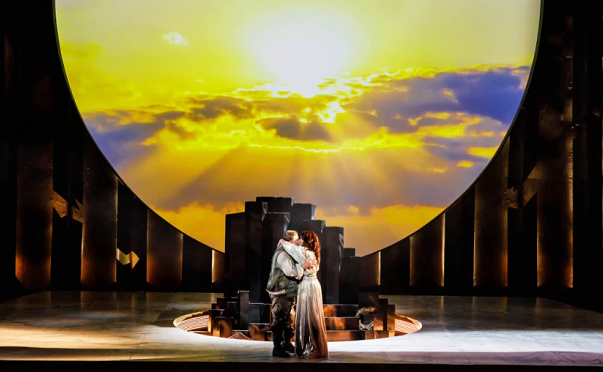 Australia Wagner, Siegfried: Soloists, Melbourne Opera Orchestra / Anthony Negus (conductor). Livestreamed on Australian Digital Concert Hall from the Ulumbarra Theatre, Bendigo, 31.3.2023. (JPr)
Australia Wagner, Siegfried: Soloists, Melbourne Opera Orchestra / Anthony Negus (conductor). Livestreamed on Australian Digital Concert Hall from the Ulumbarra Theatre, Bendigo, 31.3.2023. (JPr)

Production:
Director – Suzanne Chaundy
Set design – Andrew Bailey
Costume designer – Harriet Oxley
Lighting designer – Rob Sowinski
Video designer – Chris Hocking
Cast:
Siegfried – Bradley Daley
Brünnhilde – Antoinette Halloran
Mime – Robert Macfarlane
The Wanderer – Warwick Fyfe
Alberich – Simon Meadows
Fafner – Steven Gallop
The Woodbird – Rebecca Rashleigh
Erda – Deborah Humble
When I think of Siegfried it reminds me of the anecdote about an English National Opera performance on tour to Manchester in 1976. Alberto Remedios recalled: ‘Siegfried approaches with the usual trepidation the sleeping form of Brünnhilde [Rita Hunter], dreading that moment of potential comedy when he removes her breastplate and starts back with the words ‘Das is kein Mann’. His heroic bearing eliminated any possibility of audience titters at this point, but even his professionalism was strained to the limit when he saw beneath the breastplate a note – ‘DO NOT DISTURB, EARLY MORNING TEA 7.30 AM’. The legendary Wagnerian singers, Remedios and Hunter, both ended their days in Australia, and I am sure – knowing them well as I did – they would have admired director Suzanne Chaundy’s straightforward storytelling with little to have you scratching your head about despite its odd eccentricities.
As for – what the Germans call – Personenregie (the art of moving people about on the stage), as this Ring continues, I realise that more often than not one singer is put at the front on one side of the stage and another over the other side. Both frequently face resolutely forward and sing out into the audience regardless of the situation of the opera and the emotions they are expressing. If they do actually move, they often circle each other and just swap sides. This is not all the time of course, and neither is it all bad as it is great to hear all the words sung so clearly, even though it can look like a very elaborate concert performance at times.
Conductor Anthony Negus continued his up-tempo approach to the Ring with a quick Siegfried where the first two acts together were as long as the combined length of the intervals after them. What are the Bendigo patrons doing with all their time off? Overall (excluding intervals), this Siegfried lasted just over 3¾ hours, perhaps the fastest I have seen and heard (live or online). On the surface it is all very exciting musically but as it went on I dreaded whenever the horns were contributing as they seemed to have an off night once again and it is a shame because Negus deserves the greatest virtuosity.
For Act I, Chaundy and her set designer, Andrew Bailey, provide us with the most wonderfully detailed home for Mime and Siegfried. There is a smithy – with real flames – for some proper forging of the sword, Nothung. (Well, as proper as you are likely to ever see.) Siegfried even uses charcoal, a bench vice, a rasp and bellows. There is a table covered in cooking utensils where Mime will later prepare his poisoned soup (using several eggs) which he hopes will despatch Siegfried and win for him all of Fafner’s gold and the all-important ring. The platform (Bailey’s leitmotif for his Ring) is partly lowered and what we see happens below it with metal stairs going up through the hole in its centre. There is no bear but you can’t have everything you want. Mime shuffles about wearing a brown apron, has a greying beard and glasses; Siegfried looks a bit like a hunter; and the bearded Wanderer when he comes in has his spear, black fedora over his left eye and wears a plain grey overcoat. Unfortunately, at the concluding ‘So schneidet Siegfrieds Schwert’ there is no destruction just some flashing lights and the shiny sword being waved around.
As the music begins for Act II we are beneath the platform once again and Fafner – with the Tarnhelm on his head – is seen securing the hoard before the floor is lowered over it creating Fafner’s cave (Neidhöhle). Strips of material hang down suggesting vine covered tree trunks and the floor is dappled. As suggested above, the confrontation between Alberich and the Wanderer, Siegfried and Mime (relishing his flask full of deadly liquid) and Mime and Alberich, were mostly confined to the front of the stage. As Siegfried sits on the edge of the platform there is more video (from Chris Hocking) of the birds whose singing attracts him, whilst the Woodbird appears onstage observing everything and looking rather like a barefooted new ager in what seemed a simple green crocheted dress. Siegfried even has a cow’s horn to blow and as the Woodbird dances a huge eye and scaley snout of Fafner (in his dragon form) is seen at the back. Siegfried seems unusually remorseful in having killed Fafner and Mime and sits their bodies back-to-back at the front (of course). Thanks to Fafner’s blood the Woodbird warned Siegfried of Mime’s treachery and about the Tarnhelm and ring. She now tells him about Brünnhilde and he sets off to win her with more fluttering birds crossing the stage.
Act III begins underground where the Wanderer rouses a semaphoring Erda looking an angelic figure in more crochet (I think) with the silent eerie-looking face from Das Rheingold projected at the rear before it was joined by three more (the Norns, perhaps?) looking on. Now above again, the Wanderer challenges Siegfried and attempts to stop him getting to Brünnhilde, though why he rarely sang towards Siegfried puzzled me. The Wanderer’s hat is tipped off by Nothung which also breaks his spear to a backdrop of stormy clouds. Unfortunately the curtain comes down, though after some images of flames, it eventually rises for the basalt columns – which were there at the start of the act but are important now – to appear as in Die Walküre with Brünnhilde asleep on the large central mass of them, bathed in smoke and red light. The spotlit figure doesn’t have a breastplate and is all too clearly ‘not a man’! Brünnhilde is woken up by Siegfried’s kiss and is in a shiny, silvery gown with a sash around the waist and clutches the wolfskin she slept on. Soon Siegfried makes a grab for her but gets fended off though mostly they are far apart when they sing, however they do finally embrace – to the sun poking through the clouds at the back – as Brünnhilde succumbs to Siegfried’s passionate entreaties.

I need to always mention I am listening through loudspeakers and have no real idea of the true size of the singers’ voices and how they were heard in the theatre, but my impression was that Bradley Daley was ideal as Chaundy’s oddly mild-mannered, man-child Siegfried. He seems to have a wonderful way of colouring his words, a pleasant lyricism and secure top notes. He did tire a little towards the end, but that is no surprise considering how much he must sing before the final scene. Perhaps because this was his last appearance in this Ring cycle, Warwick Fyfe was much more vocally animated as the Wanderer than as Wotan and it sounded as if the Wanderer’s notes lay better for his dark, imposing bass-baritone. Robert Macfarlane sang Mime in Rheingold, but gets a better opportunity to impress in this opera and his was a more understated portrayal and more straightforwardly sung than by some interpreters. Also returning were Simon Meadows’s hateful – and feeling hard done by – Alberich; Steven Gallop as the avaricious (and, on this occasion, rather unthreatening) Fafner; and Deborah Humble as the otherworldly Erda. All sang well but Humble’s profound and portentous voice stood out. Rebecca Rashleigh’s Woodbird was sweetly sung and appealingly performed.
Sadly, Antoinette Halloran was again, for me, the weak link in the cast as Brünnhilde and the role could either be too soon, or a step too far, for her – at times, slightly unruly sounding – soprano voice. Halloran has a very expressive middle range that she employed effectively as Brünnhilde realises her true love for Siegfried, which she acted well; however, she was often overstretched for Brünnhilde’s highest notes.
This Siegfried was well received – deservedly so – by the audience in Bendigo but interestingly during the curtain calls you could hear a (lone?) horn player practising a few bars!
Jim Pritchard
